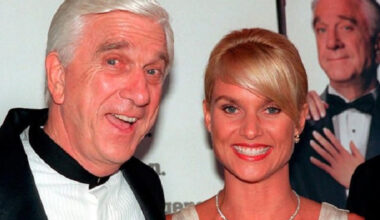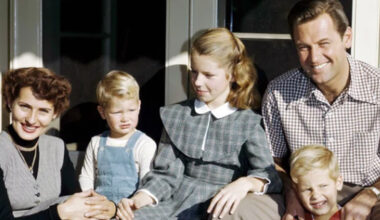Basic Information:
| Field | Detail |
|---|---|
| Name (as requested) | Louis Hezekiel Brown |
| Alternate forms used publicly | Louis H. Brown; Louis H. Brown Jr. |
| Birthplace (reported) | Havana, Kansas (reported in contemporary profiles) |
| Birth / Death (reported) | Birth: early 20th century (records vary); Death: widely reported 2014 (some records conflict) |
| Military service | U.S. Army Air Forces — WWII; B-17s and photographic missions (captain) |
| Postwar work | Military press / Stars and Stripes contributor; real estate; insurance; community advocate |
| Spouse | Juditha (Juditha Anne Baur / Juditha Anne Brown) |
| Children (selected) | Denise Brown, Nicole Brown Simpson (1959–1994), Dominique Brown, Tanya Brown, plus other children reported from earlier relationships |
| Notable grandchildren | Sydney Brooke Simpson (granddaughter through Nicole) |
Acting on a Quiet Stage — An Introduction in My Own Voice
I approach Louis Hezekiel Brown like a film camera creeping down a quiet suburban street at dusk: there’s texture in the shadows, faces you think you know but haven’t fully seen, and an archive of light in which whole human dramas once played out. I say “I” because this is the kind of family story that draws you into confessionals — people leaning toward the lens, offering one-liners, small regrets, big loves. Louis was, by all accounts, a solidly private man who lived with public reverberations: World War II pilot, a postwar journalist in uniform, a father whose family name would much later be magnified on national television for reasons he never could have scripted.
Early Life, War, and the Habits of a Mid-Century Man
Numbers and dates anchor us: World War II in the 1940s — he flew B-17s; he came home with a ribbon-strewn uniform and a hunger for steadiness. I picture him with aviator sunglasses, hands steady on a newspaper — the Stars and Stripes — where he later worked while stationed in Europe. That transitional decade — 1945 to 1955 — is where many veterans built civilian lives on the backbone of military discipline and an appetite for new opportunity. Louis’s trajectory from wartime captain to family man and businessman fits that pattern: precise, quietly ambitious, a man who could translate an aerial photo mission into a career behind ink and later into real estate and insurance deals on the ground.
Family Web: Names, Tension, and Tenderness
If a family is a constellation, Louis was one of its bright but reliably steady stars — not always the comet that crosses headlines, but the gravitational force nonetheless. His marriage to Juditha produced children raised partly abroad (Frankfurt, West Germany is where at least one daughter was born) and then back in the United States — Orange County, California, among the palm trees and car culture of the late 20th century. The roster of daughters and sons reads like the credits of a long, complex film:
- Denise Brown — daughter, often a voice in later family interviews and retrospectives.
- Nicole Brown Simpson (1959–1994) — daughter whose life, marriage, and tragic death became a defining and public chapter for the family. Born in Frankfurt, raised in California, Nicole’s arc shifted the Brown family into constant public attention after 1994.
- Dominique Brown, Tanya Brown — siblings who also carried the family name and memory into documentary work and interviews.
- Additional children reported from earlier relationships — names that surface in obituaries and genealogies, emphasizing that Louis’s family map was broader than any single headline.
I like to imagine family dinners where accents mixed — stories of Germany, stories of Kansas, and later, the tangle of living in Southern California. Those meals are the scaffolding behind the moments that became public: a father in the courtroom, a mother at the edge of tears, children learning to be both private people and reluctant public figures.
Career, Reinvention, and Public Role
Louis’s professional life has three acts. Act I: wartime service — captain of B-17 missions and photographic sorties. Act II: military press and journalism during postwar Europe — working for Stars and Stripes, translating military life into reportage and record. Act III: American civilian life — insurance, real estate, community presence — the slow trades that let a man buy security for children and a roof over their heads.
He had the kind of résumé that reads modestly on paper and intensely in family lore. There’s an element of mid-century American reinvention here: from cockpit to newsroom to business office — an arc that feels cinematic because it is stitched across continents and decades.
Public Moments, Trialroom Light, and Legacy in Memory
If Louis’s life was largely quiet, moments made it loud. The O. J. Simpson trial era — the springboard to national obsession — placed the Brown family in a literal and figurative courtroom of public opinion. Louis and Juditha appeared in archival footage, photographed in shock and resolve, and the family’s private grief became a kind of civic text, reinterpreted endlessly in documentaries and anniversary coverage. I’ve watched those clips as if rewinding a film to find nuance: the tilt of a head, the moment someone squeezes another’s hand, the way time stretches when it’s being watched by a nation.
Yet legacy is more than headline aftershocks. The family’s later interviews, foundation work to address domestic violence, and the testimony of children — all of these are the quieter credits that roll after the sensational part has been edited away.
A Timeline Table (Key Dates & Numbers)
| Year / Period | Event |
|---|---|
| 1940s | World War II service — B-17 missions; captain in U.S. Army Air Forces |
| 1959 | Birth of Nicole (Frankfurt, West Germany) |
| 1994 | Nicole Brown Simpson murdered — a turning point that placed the Brown family under national scrutiny |
| 2014 (reported) | Widely reported year of Louis’s death; some public records list conflicting dates |
Numbers here aren’t just facts; they’re beats in a family rhythm — arrival, rupture, public attention, and the quieter accounting of life after headlines fade.
FAQ
Who was Louis Hezekiel Brown?
He was a mid-century American who served as a U.S. Army Air Forces captain in WWII, later worked in military press and civilian businesses, and was the father of Nicole Brown Simpson and several other children.
Where was he from and where did he serve?
He was reported to have roots in Kansas and served in Europe and North Africa during World War II, flying B-17s and photographic missions.
Who are his closest family members?
His wife Juditha and daughters Denise, Nicole, Dominique, and Tanya are the most publicly referenced immediate family; he also had children reported from earlier relationships.
Did he have a public career beyond the military?
Yes — postwar work included roles with military press outlets and later careers in insurance, real estate, and community involvement.
When did he die?
Contemporary obituaries widely report his death in 2014, though some records show conflicting dates.
Is there a known net worth for Louis Hezekiel Brown?
No reliable public estimate of his net worth is available; records note occupations but do not publish definitive financial figures.
How did the family respond publicly after 1994?
Family members participated in interviews, documentaries, and advocacy work, and they were often present in public remembrance and legal proceedings tied to Nicole’s case.
What should a reader take away about the family?
That they lived a life threaded by ordinary domesticity and extraordinary public attention — a family whose private heartbeat occasionally became a national pulse.



